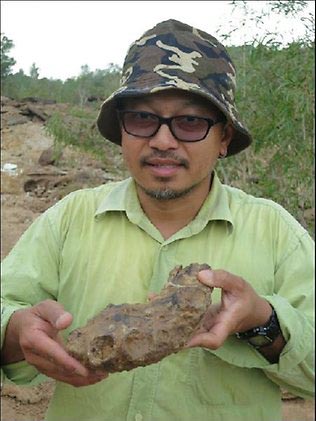Monster Prehistoric Crocodile from Queensland
Huge “Super-Croc” May be Biggest Crocodile of All Time
Scientists in Queensland (Australia) have uncovered part of a fossilised jawbone that suggests the rivers and lakes of ancient Australia may have been home to a super-sized, monster prehistoric crocodile that would not have looked out of place if it had lived at the time of the dinosaurs. The island of Australia has been isolated from other land masses for millions of years, this has permitted the fauna and flora to evolve without competition from other genera migrating into the country. Marsupial mammals still dominate today and in the past Australia had its own, unique mega-fauna including cow-sized wombats, a giant monitor lizard called megalania and fearsome predators such as marsupial lions. The megafaunal assemblage of Australia survived into the Pleistocene but the arrival of human settlers and climate change led to the extinction of most of these animals.
Monster Prehistoric Crocodile
Scientists were aware that crocodiles had diversified and evolved into a myriad of different species. The discovery of a partial jawbone suggests that at least one type of crocodile evolved into a giant, perhaps a contender for the biggest crocodylian known from the fossil record. Australia is home to the Saltwater crocodile, otherwise known as the Estuarine crocodile (Crocodylus porosus), it is the largest species of reptile on the planet, with males reaching lengths in excess of seven metres and weighing more than a tonne. It is often referred to as “Australia’s own dinosaur”, but like all crocodylians, it is only very distantly related to the Dinosauria. University of New South Wales palaeontologists who found the fragment of crocodile jaw state that this individual was at least eight metres long and there may have been others of its kind that were even larger, perhaps reaching the size of Sarcosuchus, a twelve-metre-long crocodylian that lived during the Late Cretaceous geological period and preyed on dinosaurs.
The fossil was found at a dig site at Floraville Station, on the Liechardt River, between the towns of Normanton and Burketown in the Gulf of Carpentaria (Queensland). This location has provided scientists with a number of Pleistocene and older Pliocene fossils including the remains of giant wombats (diprotodontids).
Australian Scientists Report on Giant Fossil Crocodile
Picture credit: Adapted from the Sunday Mail (Queensland)
The fossil was discovered by undergraduate Bok Khoo from the University of New South Wales on July 10th, it is part of the lower jaw (dentary). The fossil bearing strata consists of several layers which represent ancient river deposits. The dig site is close to the current course of the Liechardt River and the sediment is disturbed when the water levels rise and this helps to expose new fossil finds. The river may help reveal fossil material but being close to the river does have its drawbacks. The location is known for its Saltwater and Freshwater crocodiles as well as sharks and sting rays. The field team have to be wary of attacks from extant crocodiles as they search for the fossilised remains of extinct ones.
Gilbert Price, a palaeontologist with Queensland University has commented that the jaw bone represents a substantial individual, one crocodile that was very probably an apex predator in the region. The fossil has yet to be accurately dated, it belongs to either the Pleistocene or the earlier Pliocene Epoch. The Pliocene ended approximately 1.6 million years ago, the Pleistocene Epoch followed and lasted until approximately 10,000 years ago. The climate around the Gulf of Carpentaria today has two distinct seasons, a wet season and a long dry season. For most of the Pliocene and Pleistocene Epochs, this part of Australia was much more humid and wetter. Scientists have speculated that this huge crocodile could have lived as far south as the State of Victoria. The research team hope to subject the specimen to radiocarbon dating, this will give them a better idea as to whether the fossil represents a known species of crocodile or whether it is new to science.
Student Bok Khoo with the Crocodile Fossil
Picture credit: Laurie Beirne
The fossil is eroded, a result of the river action and the teeth have been lost but the tooth sockets which measure up to four centimetres in diameter indicate that this predator had very large, conical-shaped teeth. Professor Mike Archer of the University of New South Wales described the fossil as “weird” and he could not rule out that this fossil find could represent a new species.
He jokingly added:
Although the scientists are hopeful that they may be able to find more fossils of this unusually large crocodylian they have postulated that it could represent a member of the crocodile genus known as Pallimnarchus, perhaps being a specimen of Palimnarchus pollens, the largest species in the genus. The Pallimnarchus crocodiles belong to an extinct family of crocodiles known as the Mekosuchinae. These crocodiles evolved in the Palaeogene geological period, following the extinction of the dinosaurs and spread across the south Pacific evolving into a number of diverse forms. Some Mekosuchinae crocodiles were water-based ambush predators just like today’s “Salties”, but other types evolved entirely differently. A number of these types of crocodile became fleet-footed, land based predators, some even adapted to an arboreal existence becoming apex predators in forested habitats.
The Australian scientists are keen to continue their fieldwork in the hope of finding more skull material from this ancient giant.



